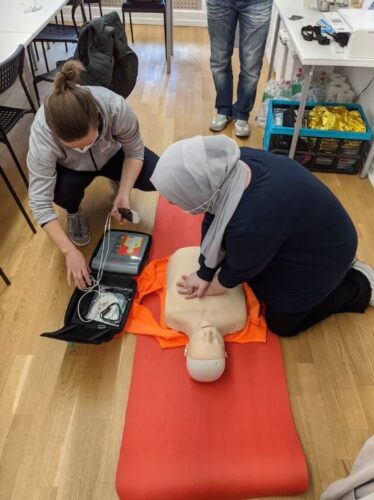The three principles of first aid are the responsibilities you must recite when completing a first aid course. It’s integral knowledge to know when responding to an emergency. We always remember that the ultimate goal is to save lives – something these 3 guiding principles will help you achieve.
What is first aid?
First aid is the medical attention given to a person during an emergency, and should be administered as soon as possible after the injury has taken place. In order to perform first aid properly, you will need training on how to clean and treat wounds, treat burns, perform CPR, apply bandages, and much more! First aid training takes 1 day, and costs only £60+VAT at SAMS.
What Are the Three P’s of First Aid?
The PPP acronym in first aid stands for:
- Preserve life
- Prevent deterioration
- Promote recovery
These 3 Ps are exactly what a first aider at the scene will follow as their responsibilities. Sometimes first aiders will be put into a awkward situation where it’s quite literally life or death. By following your training correctly, you as a first aider will remain calm in these stressful moments, and able to implement your knowledge to save a life.
1. Preserve life
Your first priority as a first aider is to preserve life. If you find yourself in an emergency situation, this is the first part of your training you will look to.
Firstly, assess the area. Are there any dangers? Always protect yourself first. If you’re able to get to the injured person, then assess them with these easy steps. Proceed by applying the C-A-B protocol to an injured person:
- Circulation – check the quality of their circulation and adjust if needed.
- Airway – ensure the casualty has an airway.
- Breathing – makes sure the victim is breathing.
If it seems like the person is not breathing, then you would proceed with CPR (cardiopulmonary resuscitation) exactly how you’re taught at a SAMS Emergency First Aid course, and continue until professional help arrives. As this can be physically taxing, it’s sometimes necessary to hand over to someone else with appropriate training so that they can continue providing CPR.
Other emergency situations such as heavy bleeding might also have occurred. In these situations, you would also put in place the training you’ve learned in order to prevent further bleeding.
2. Prevent Deterioration
The second step is to prevent deterioration. Bear in mind that you are not a medical professional, even with training, so always make sure to call a medical professional before starting any first aid.
This step includes making the person feel as comfortable as they can, and most importantly putting them in a stable condition.
What you can do is:
- If it’s a seizure victim, keep a close eye on their condition.
- Give a diabetic some sugar when they are low on glucose.
- Do anything you have learned to stop any bleeding.
- A fractured arm or leg should be immobilised to prevent further injury.
If there is any bleeding, then an open wound is susceptible to infection. Wear gloves if possible and regularly disinfect and clean, especially if you’re washing any wounds.
3. Promote Recovery
Now, the third and final responsibility is to promote recovery. Of course there are a range of different situations which you will have to cater for differently with various approaches. What they’ll have in common however is that you will have to encourage them, and provide reassurance that things will be ok.
This is an approach which will be taught during your first aid course, and developed over time. To put it simply, you will provide encouraging words that build confidence and comfort in an attempt to relieve pain, and take the victim’s mind off the situation at hand.
The importance of the 3 Ps in first aid
The three Ps in first aid help you prevent the condition of a casualty from worsening while waiting for emergency services to arrive.
The less time a patient waits before treatment, the less harm they tend to come to. So when a first aider’s goal is preserving life, they will apply the best medical response in their power at that moment.
It can be as simple as assessing and calming the patient, or as immediate as performing CPR.
By following the 3 Ps, you can lower the chances of any casualties worsening whilst waiting for a medical professional to arrive at your destination. By knowing your goal is to preserve life, you will hopefully apply the best medical response you can in that significant moment.
If you are a non–first aider, you can still apply one of the Ps. Do not act on any on anything you’re unsure about, but try to comfort the person and encourage their recovery by being there for them whilst you wait for medical professionals.
What are the main responsibilities of First Aid Training?
Did you know that it takes an average of 8-19 minutes for an ambulance to arrive to a serious casualty? As a result, first aiders are often relied on for support. The ultimate aim of the 3 Ps (preserving life, preventing injury and promoting recovery) is to save lives, and reduce suffering of the victim.
Extended roles of a first aider include:
- Protecting the victim (especially if unconscious) by safely clearing any hazardous objects around the victim
- Relieving paid by giving them basic pain medication, providing icepacks or elevating the wound
- Checking vital signs and assessing the extent of trauma or spinal injuries, in order not to worsen their condition.
If you’re interested in our Emergency First Aid course, then our next course will be on May 4th 2023.
Click this link to be directed to our Emergency First Aid at Work course page.

